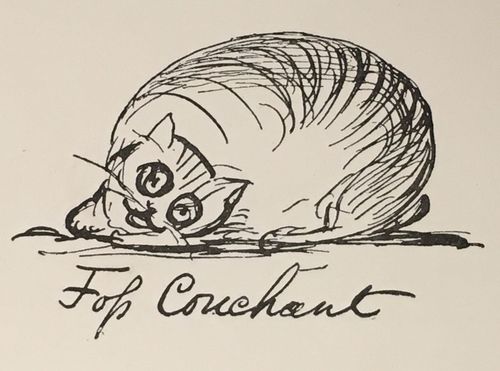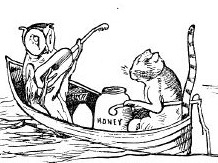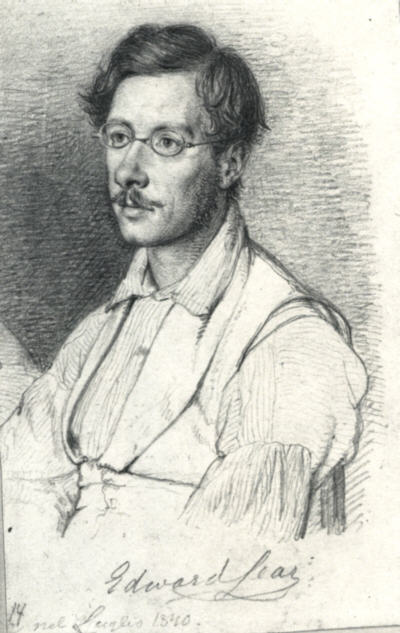|
Foss (cat)
Foss (c. 1873 – 26 November 1887), formally named Aderphos, was the pet cat of Edward Lear, the 19th-century author, illustrator, and poet. A "stumpy-tailed," "portly," and "unattractive" tabby cat, he was a favourite of Lear's and played an important role as a companion in the poet's lonely later years. Foss is mentioned frequently in Lear's correspondence and appears in his illustrations and at least one poem. Foss is said to have been the inspiration for the pussycat in Lear's illustrations for his poem "The Owl and the Pussycat". The funeral that Lear provided for Foss, which included an epigraphed headstone, is said to have been more elaborate than Lear's own. Description Foss is said to have been adopted by Edward Lear whilst a kitten in 1873, though Lear later claimed he was older. His full name was the Greek word Aderphos ( a variant of Adelphos, "brother"), but he was generally known by the shortened form of "Foss" or, particularly by Lear, "Old Foss". Foss was a tab ... [...More Info...] [...Related Items...] OR: [Wikipedia] [Google] [Baidu] |
Foss Couchant
Fos or FOSS may refer to: Companies *Foss A/S, a Danish analytical instrument company * Foss Brewery, a former brewery in Oslo, Norway *Foss Maritime, a tugboat and shipping company Historic houses * Foss House (New Brighton, Minnesota), United States * Foss and Wells House, Jordan, Minnesota, United States * Horatio G. Foss House, Auburn, Maine, United States People * Foss (surname) *Foss Shanahan (1910–1964), New Zealand diplomat * Foss Westcott (1863–1949), English bishop Places *Foss Dyke, a canal in Lincolnshire, England *Foss-Eikeland, a village in Sandnes, Norway *River Foss, a river in North Yorkshire, England, U.K. United States * Foss, Oklahoma, a town **Foss State Park *Foss, Oregon, an unincorporated community *Foss Glacier, a glacier on Mount Hinman, Washington *Foss Peak, Tatoosh Range, Washington *Foss River, a river in Washington Other uses *Foss (band), an El Paso, Texas-based rock band *Foss (cat), the pet of Edward Lear * Free and open-source softwa ... [...More Info...] [...Related Items...] OR: [Wikipedia] [Google] [Baidu] |
Attitude (heraldry)
In heraldry, the term attitude describes the ''position'' in which a figure (animal or human) is emblazoned as a charge, a supporter, or as a crest. The attitude of an heraldic figure always precedes any reference to the tincture of the figure and its parts. Some attitudes apply only to predatory beasts, exemplified by the beast most usual to heraldry — the heraldic lion; other terms apply to docile animals, such as the doe, usually emblazoned as a "hind". Other heraldic attitudes, such as ''volant'', describe the positions of birds, exemplified by the bird most usual to heraldry — the heraldic eagle; moreover, birds also are described by the positions of their wings. The term ''naiant'' (swimming) applies to fish, swans, ducks, and geese. The term ''segreant'' is applied to the griffin, as an approximation of ''rampant'', and is applied to the dragon. Animal figures are positioned in profile, facing dexter (the viewer's left), and persons are shown ''affronté'' (facing t ... [...More Info...] [...Related Items...] OR: [Wikipedia] [Google] [Baidu] |
Cats In Literature
The cat (''Felis catus'') is a Domestication of the cat, domestic species of small carnivorous mammal. It is the only domesticated species in the family Felidae and is commonly referred to as the domestic cat or house cat to distinguish it from the wild members of the family. Cats are commonly kept as house pets but can also be farm cats or feral cats; the feral cat ranges freely and avoids human contact. Domestic cats are valued by humans for companionship and their ability to kill rodents. About 60 cat breeds are recognized by various cat registries. The cat is similar in Cat anatomy, anatomy to the other felid species: they have a strong flexible body, quick reflexes, sharp teeth, and retractable claws adapted to killing small prey. Their night vision and sense of smell are well developed. Cat communication includes Animal communication, vocalizations like meowing, purring, trilling, hissing, growling, and grunting as well as Cat body language, cat-specific body language. ... [...More Info...] [...Related Items...] OR: [Wikipedia] [Google] [Baidu] |
Cats In Art
The cat (''Felis catus'') is a domestic species of small carnivorous mammal. It is the only domesticated species in the family Felidae and is commonly referred to as the domestic cat or house cat to distinguish it from the wild members of the family. Cats are commonly kept as house pets but can also be farm cats or feral cats; the feral cat ranges freely and avoids human contact. Domestic cats are valued by humans for companionship and their ability to kill rodents. About 60 cat breeds are recognized by various cat registries. The cat is similar in anatomy to the other felid species: they have a strong flexible body, quick reflexes, sharp teeth, and retractable claws adapted to killing small prey. Their night vision and sense of smell are well developed. Cat communication includes vocalizations like meowing, purring, trilling, hissing, growling, and grunting as well as cat-specific body language. Although the cat is a social species, they are a solitary hunter. As a preda ... [...More Info...] [...Related Items...] OR: [Wikipedia] [Google] [Baidu] |
1887 Animal Deaths
Events January–March * January 11 – Louis Pasteur's anti-rabies treatment is defended in the Académie Nationale de Médecine, by Dr. Joseph Grancher. * January 20 ** The United States Senate allows the Navy to lease Pearl Harbor as a naval base. ** British emigrant ship ''Kapunda'' sinks after a collision off the coast of Brazil, killing 303 with only 16 survivors. * January 21 ** The Amateur Athletic Union (AAU) is formed in the United States. ** Brisbane receives a one-day rainfall of (a record for any Australian capital city). * January 24 – Battle of Dogali: Abyssinian troops defeat the Italians. * January 28 ** In a snowstorm at Fort Keogh, Montana, the largest snowflakes on record are reported. They are wide and thick. ** Construction work begins on the foundations of the Eiffel Tower in Paris, France. * February 2 – The first Groundhog Day is observed in Punxsutawney, Pennsylvania. * February 4 – The Interstate Commerce Act ... [...More Info...] [...Related Items...] OR: [Wikipedia] [Google] [Baidu] |
A Beach Full Of Shells
''A Beach Full of Shells'' is the fifteenth studio album by Al Stewart, released in 2005. Like most of Stewart's later works, much of the content of the CD alludes to people or moments in history. Historical references * "The Immelman Turn": refers to the aerobatic maneuver of the same name. The narrator, a Barnstormer, pilots a Curtiss "Jenny". * "Mr. Lear": about the nineteenth-century English poet Edward Lear. Lear's cat Foss is mentioned, and his poems "The Pobble Who Has No Toes" and "Uncle Arly" are referenced. * "Somewhere in England, 1915": The narrator, living in 2005, dreams many scenes, including the 1945 film ''Brief Encounter'', the British poets Siegfried Sassoon and Wilfred Owen in the trenches of World War I and the last farewell of Violet Asquith (daughter of British Prime Minister H. H. Asquith) and Rupert Brooke. He then wakes up, and sees on that day's newspaper "a man on the cover we all know, defying the fates" who "seems very sure" of himself. * "Kath ... [...More Info...] [...Related Items...] OR: [Wikipedia] [Google] [Baidu] |
Al Stewart
Alastair Ian Stewart (born 5 September 1945) is a Scottish born singer-songwriter and folk-rock musician who rose to prominence as part of the British folk revival in the 1960s and 1970s. He developed a unique style of combining folk-rock songs with delicately woven tales of characters and events from history. Stewart is best known for his 1976 hit single " Year of the Cat", from the platinum album of the same name. Though '' Year of the Cat'' and its 1978 platinum follow-up ''Time Passages'' brought Stewart his biggest worldwide commercial successes, earlier albums such as '' Past, Present and Future'' from 1973 are often seen as better examples of his intimate brand of historical folk-rock, a style to which he returned in later albums. Stewart is a key figure in British music and he appears throughout the musical folklore of the revivalist era. He played at the first-ever Glastonbury Festival in 1970, knew Yoko Ono before she met John Lennon, and shared a London flat with ... [...More Info...] [...Related Items...] OR: [Wikipedia] [Google] [Baidu] |
Edward Lear And His Cat Foss 1885
Edward is an English given name. It is derived from the Anglo-Saxon name ''Ēadweard'', composed of the elements '' ēad'' "wealth, fortune; prosperous" and '' weard'' "guardian, protector”. History The name Edward was very popular in Anglo-Saxon England, but the rule of the Norman and Plantagenet dynasties had effectively ended its use amongst the upper classes. The popularity of the name was revived when Henry III named his firstborn son, the future Edward I, as part of his efforts to promote a cult around Edward the Confessor, for whom Henry had a deep admiration. Variant forms The name has been adopted in the Iberian peninsula since the 15th century, due to Edward, King of Portugal, whose mother was English. The Spanish/Portuguese forms of the name are Eduardo and Duarte. Other variant forms include French Édouard, Italian Edoardo and Odoardo, German, Dutch, Czech and Romanian Eduard and Scandinavian Edvard. Short forms include Ed, Eddy, Eddie, Ted, Teddy and Ned. Peop ... [...More Info...] [...Related Items...] OR: [Wikipedia] [Google] [Baidu] |
The Owl And The Pussy-Cat
"The Owl and the Pussy-cat" is a nonsense poem by Edward Lear, first published in 1870 in the American magazine '' Our Young Folks: an Illustrated Magazine for Boys and Girls'' and again the following year in Lear's own book ''Nonsense Songs, Stories, Botany, and Alphabets''. Lear wrote the poem for a three-year-old girl, Janet Symonds, the daughter of Lear's friend and fellow poet John Addington Symonds and his wife Catherine Symonds. The term " runcible", used for the phrase "runcible spoon", was invented for the poem. Synopsis "The Owl and the Pussy-cat" features four anthropomorphic animals – an owl, a cat, a pig, and a turkey – and tells the story of the love between the title characters who marry in the land "where the Bong-tree grows". Unfinished sequel Portions of an unfinished sequel, "The Children of the Owl and the Pussy-cat" were published first posthumously, during 1938. The children are part fowl and part cat, and love to eat mice. The family live by pla ... [...More Info...] [...Related Items...] OR: [Wikipedia] [Google] [Baidu] |
Edward Lear
Edward Lear (12 May 1812 – 29 January 1888) was an English artist, illustrator, musician, author and poet, who is known mostly for his literary nonsense in poetry and prose and especially his limerick (poetry), limericks, a form he popularised. His principal areas of work as an artist were threefold: as a draughtsman employed to make illustrations of birds and animals; making coloured drawings during his journeys, which he reworked later, sometimes as plates for his travel books; and as a (minor) illustrator of Alfred, Lord Tennyson's poems. As an author, he is known principally for his popular nonsense collections of poems, songs, short stories, botanical drawings, recipes and alphabets. He also composed and published twelve musical settings of Tennyson's poetry. Biography Early years Lear was born into a middle-class family at Holloway, London, Holloway, North London, the penultimate of 21 children (and youngest to survive) of Ann Clark Skerrett and Jeremiah Lear, a stoc ... [...More Info...] [...Related Items...] OR: [Wikipedia] [Google] [Baidu] |
Sanremo
Sanremo (; lij, Sanrémmo(ro) or , ) or San Remo is a city and comune on the Mediterranean coast of Liguria, in northwestern Italy. Founded in Roman times, it has a population of 55,000, and is known as a tourist destination on the Italian Riviera. It hosts numerous cultural events, such as the Sanremo Music Festival and the Milan–San Remo cycling classic. Name The name of the city is a phonetic contraction of ''Sant'Eremo di San Romolo'', which refers to Romulus of Genoa, the successor to Syrus of Genoa. It is often stated in modern folk stories that Sanremo is a translation of Saint Remus. In Ligurian language (Romance), Ligurian, his name is ''San Rœmu''. The spelling ''San Remo'' is on all ancient maps of Liguria, the ancient Republic of Genoa, Italy in the Middle Ages, the Kingdom of Sardinia, and the Kingdom of Italy. It was used in 1924 in official documents under Benito Mussolini, Mussolini. This form of the name appears still on some road signs and, more rarely, in ... [...More Info...] [...Related Items...] OR: [Wikipedia] [Google] [Baidu] |


.jpg)



